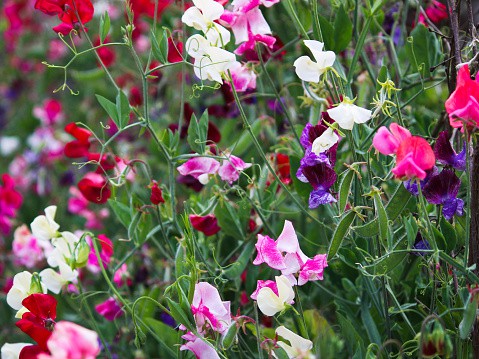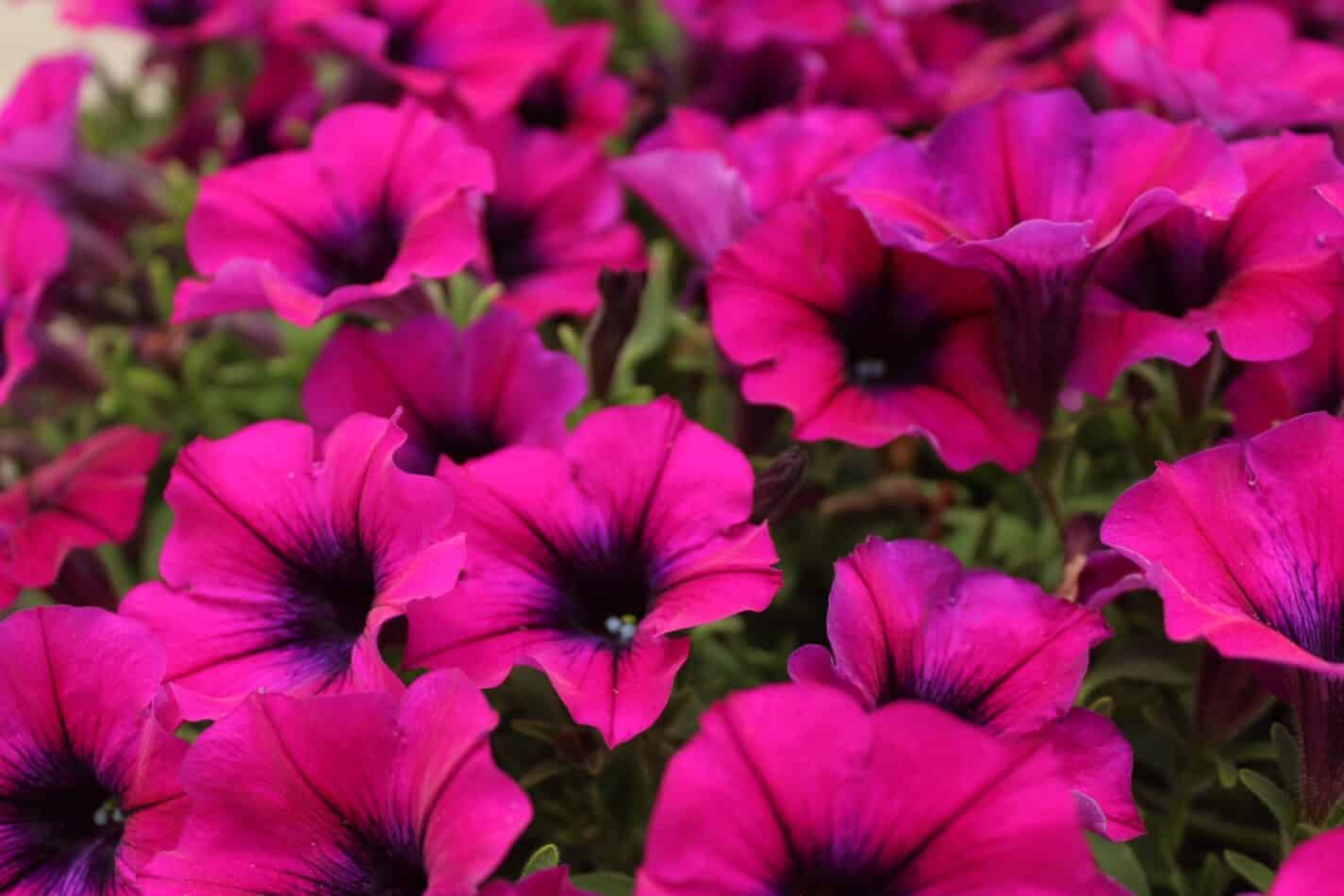Sweet Pea (Lathyrus Odoratus) is a bushy deciduous shrub that is prized for its highly fragrant blooms. This plant produces short-tubed, white to cream flowers with long stamens that form a line along each stem from late winter through to early spring. It grows up to 10 feet tall and wide, making it an ideal backdrop or screen. Just be sure you can appreciate its winter perfume and pretty flowers.
Sweet Pea belongs to the Lathyraceae family and is a type of perennial flowering plant. It is native to Southern Europe, Northern Africa as well as western and central Asia. This plant is also known as the common pea, garden pea, green pea, and grass pea.
Meaning and symbolism
Sweet Pea has been associated with transmitting delicate and happy messages for hundreds of years. In France, for centuries Sweet Pea was called ‘Eve’s Tears’, in reference to the tears shed by her when being expelled from the Garden of Eden. The flower was also used to symbolize pleasure in Greek mythology. One of the most famous stories associated with this flower is that of Ajax who, mourning the death of Achilles, used Sweet Pea as a means of remembrance.
In the Victorian era, Sweet Pea became popular in England and they developed the language of flowers. In this culture, Sweet Pea meant goodbye, blushing, and delicate pleasures.
History, mythology, and religious significance
Sweet Pea has been around since ancient times. It was cultivated in the Mediterranean, Asia, and Africa as early as 600 B.C. In the Middle Ages, this species of flower was given as a sign of omen and blessing. The usage of Sweet Pea was popular in Scotland during the 1500s and Irish monks used this flower in medicine, specifically for fever.
Certain types of Sweet Pea have religious symbolism related to the Garden of Eden. In Christianity, Sweet Pea is associated with humility, a quality encouraged and held in high esteem by Jesus. Hinduism, venerates Sweet Peas, creating a myth that Lakshmi, the Goddess of wealth, was found in a hovering can of Sweet Pea blossoms.
Flower varieties and their defining characteristics
There are over 25 species of Sweet Pea, varying in color and form. The most popular varieties are:
Snowdrift Sweet Pea – It is a trailing or climbing variety with single white flowers. It produces numerous blooms forming arching sprays. This plant resists disease and slugs and is quite tolerant of poor soils.
Royal Family Sweet Pea – This variety is one of the newest releases with deep blue, lightly scented flowers. It grows to a metre tall when trained onto poles and will prove to be hardy.
Cupids Pink Sweet Pea – This is a vigorous creeper that blooms from early summer to late autumn with clear pale pink flowers.
Heirloom Sweet Pea – This is an old-fashioned variety that dates back to the early 1800s. It has single, purple flowers and white wings. The scent is highly regarded and can be used to make perfume.
Blushing Brides Sweet Pea – This is a warm pink variety with a sweet scent and excellent perfume. It is a medium-tall growing variety and blooms from spring until late summer.
How to plant
Sweet Pea’s make excellent specimens for container gardens and flower beds. They should be grown in a sunny spot, in well-draining soil with a neutral to slightly alkaline pH. These flowers need a lot of water and regular fertilization every three to four weeks with a general-purpose fertilizer, as they are heavy feeders.
Always make sure that when you are buying Sweet Peas, you are getting healthy plants with minimal damage. In addition, always check the roots of the Sweet Peas to make sure that the soil is moist. When transplanting Sweet Peas into the ground, keep a spacing of about 25 cm (9.8 in). The soil should always be kept moist in order for the best flowering.
How to pot and repot
When potting Sweet Pea, it is important to use a container that is at least 6-8 inches deep. Make sure to use a container with drainage holes to ensure that the roots don’t stay in wet and soggy soil. Use a good quality soilless potting mix; the type you would usually use for vegetables. When re-potting, it is necessary to wait until the plant is two years old before you transfer it into a bigger pot.
How to prune
Sweet Peas are relatively easy to prune but require regular maintenance. Pruning can be done during the dormant season, either after the last frost or in late winter when the flower is just starting to bud. The plants should be cut back to about 18 inches above ground level. This prevents overcrowding and encourages new, healthy growth for the following season.
In addition to pruning Sweet Peas in late winter, you also need to monitor the plant for energy-sapping side shoots. Removing these side shoots will encourage the main stem to grow up and over the main stem.
Regular weeding is important to the overall health of Sweet Peas. You also want to dig around the edges of the forest to get rid of any stubborn weeds that may be growing. Besides weeding and pruning, Sweet Peas do not require any further intervention.
How to propagate
Sweet Peas can be propagated either by seed or by cuttings. Seeds can be started indoors about six weeks before the last frost. The seeds should be sown into damp, well-draining potting mix and lightly covered. Water the seedlings regularly and keep them in a sunny spot until they have established. After the danger of frost has passed, you can then transplant the seedlings into the garden.
Propagation by cuttings is done from late summer through fall and requires more skill than propagation by seeds. Take cuttings from semi-hard growth of the season and place them in damp, well-draining compost. Put the compost in a light, airy place and keep it moist. Cuttings usually take around two months to root, after which they should be ready to be growing independently.
Common pests and diseases
Sweet Pea is susceptible to some organisms including aphids, beetles, mites, and slugs. To control these pests organically, spray the plant with a solution of neem oil and water. Watch for signs of infestation and make sure to prune away any dead or dying stems or leaves to prevent the spread of disease.
Sweet Pea is also susceptible to some diseases such as botrytis, root rot, and mildew. To prevent these diseases, keep the plants well-watered, but make sure that the soil does not get waterlogged. Mulch around the plants to help retain moisture and keep the soil cool.
Three frequently asked questions about Lathyrus Odoratus
Q. How often should I water my Sweet Pea plant?
A. Sweet Peas need to be watered regularly and deeply. In summer, this means giving the plant at least 1 inch of water every week, depending on the temperature and how dry the soil is. In cooler climates, it is best to water the Sweet Peas once every two weeks. It is important to make sure not to overwater the Sweet Peas as this can cause root rot.
Q. How long do Sweet Pea flowers last?
A. Depending on the variety, Sweet Peas can flower from late spring to late summer or even early fall. The individual blooms typically last between 5 and 10 days but some varieties can last up to three weeks.
Q. Are Sweet Peas poisonous to animals?
A. Sweet Peas are not known to be toxic to humans or animals, however, if a large amount of seed is ingested, it can cause gastrointestinal upset. If you have pets, it is best to keep an eye on them when they are around Sweet Peas, just to be on the safe side.
A table fact sheet, with data
| Flower | Data |
|---|---|
| Sweet Pea | Lathyrus Odoratus |
| Family | Lathyraceae |
| Plant Type | Perennial |
| Mature Size | Up to 10’ tall/wide |
| Sun Exposure | Full sun |
| Soil Type | Well-draining |
| Soil pH | Neutral to slightly alkaline |
| Bloom Time | Late winter to early spring |
| Flower Color | White to cream |
| Hardiness Zones | 8-10 |
| Native Area | Southern Europe, Northern Africa, western & central Asia |
What we love from Amazon this week
Buy these wonderful flowers directly from Amazon:















